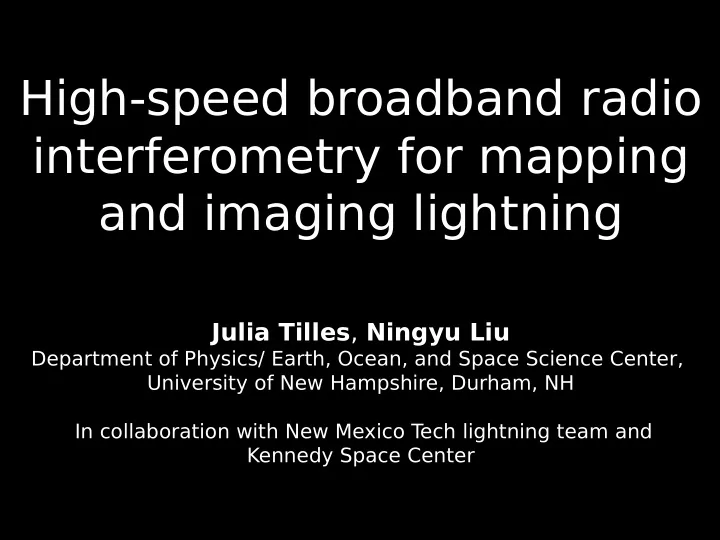

High-speed broadband radio interferometry for mapping and imaging lightning Julia Tilles , Ningyu Liu Department of Physics/ Earth, Ocean, and Space Science Center, University of New Hampshire, Durham, NH In collaboration with New Mexico T ech lightning team and Kennedy Space Center
The lightning fmash High-speed video Frame rate: 35 kfps Time/frame: 28.8 µs Playback: 30 fps
INTF system 1) Three VHF (INTF) antennas: measures dE/dt 20 – 80 MHz (roughly) used as INTF trigger 2) Fast antenna (FA): measures “fast-changing” E decay time constant τ = 100 μsec synchronized with VHF signals 3) DAQ: 16-bit @ 180 MSps (4 channels) pre-/post-trigger of 0.05/0.05 s (VHF trigger) or 1.5/1.5 s (SA trigger) 4) Slow antenna (SA): measures “slow-changing” E. decay time constant τ = 10 sec 24-bit continuously sampled @ 50 kSps used as INTF trigger
Deployment 100 m
Deployment Electric fjeld sensor VHF antenna
INTF geometry
INTF geometry Cosine plane
INTF processing
INTF processing
INTF processing
Mapping and uncertainty Cosine plane
Mapping and uncertainty Cosine plane
Mapping and uncertainty Az-El plane
Lightning processes of interest Stepped leader High-speed video Frame rate: 130 kfps Time/frame: 7.6 µs Playback: 100 fps
Lightning processes of interest Stepped leader High-speed video Frame rate: 130 kfps Time/frame: 7.6 µs Playback: 4 fps
Lightning processes of interest Stepped leader Elevation angle High-speed VHF Azimuth angle Frame rate: 3.6 Mfps Time/frame: 0.3 µs Playback: 30 fps
Lightning processes of interest Stepped leader v = 10 5 m/s 50 m 50 µs High-speed INTF map Time/dot: 1.4 µs
Lightning processes of interest Narrow Bipolar Event (NBE)/ High-speed INTF map Fast positive breakdown (FPB)
Lightning processes of interest Narrow Bipolar Event (NBE)/ High-speed INTF map Fast negative breakdown (FNB)
Conclusions 1) Can do meaningful science with three- antenna array. 2) Want better angular resolution sample higher frequencies/ use longer baselines. 3) Can only image/ map one point at a time / can’t resolve multiple sources need larger sample of u-v plane
Recommend
More recommend